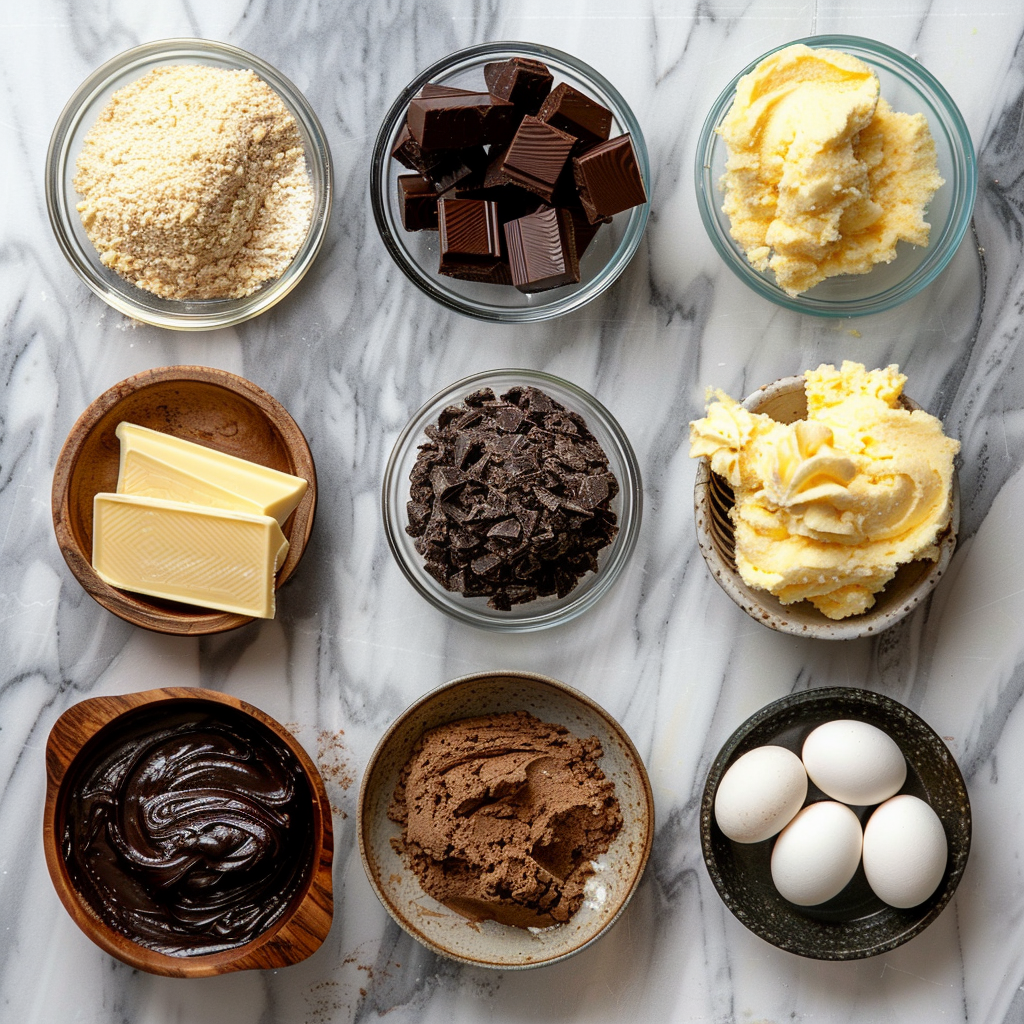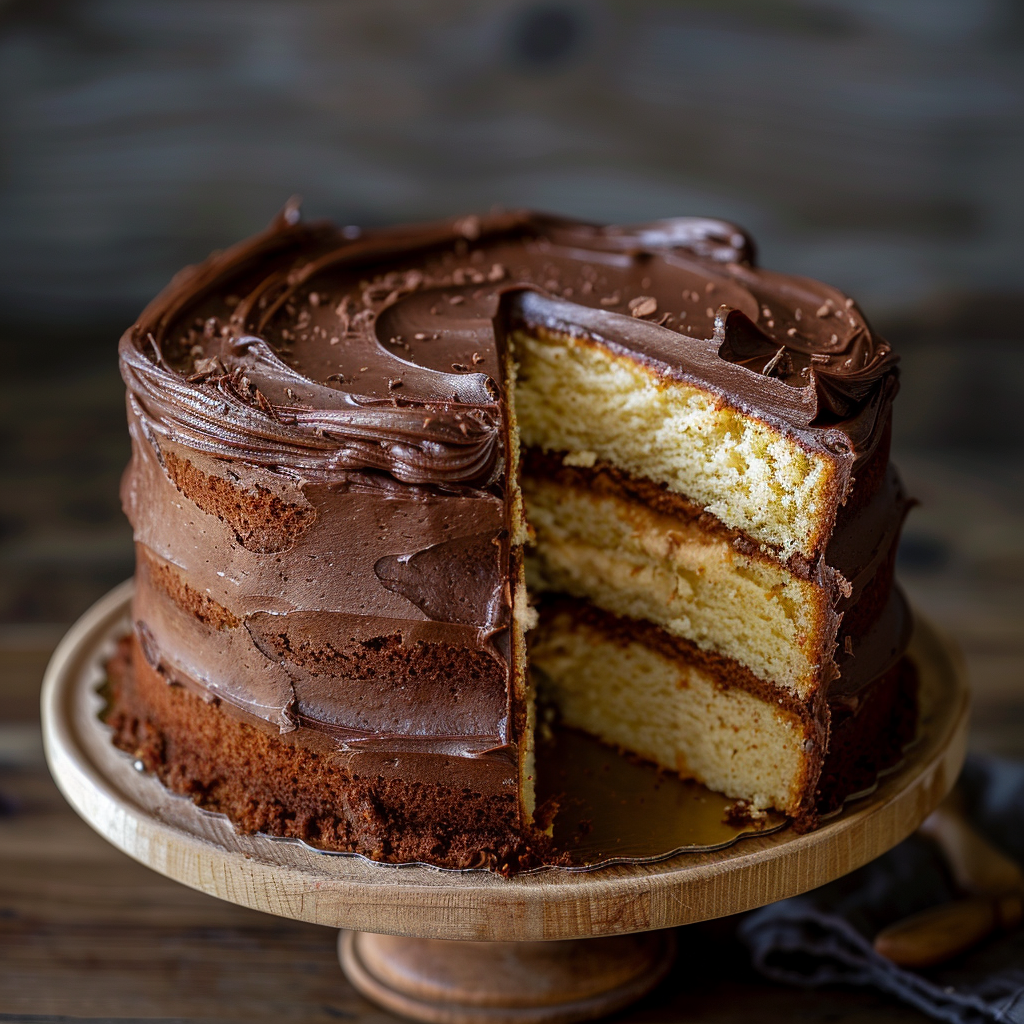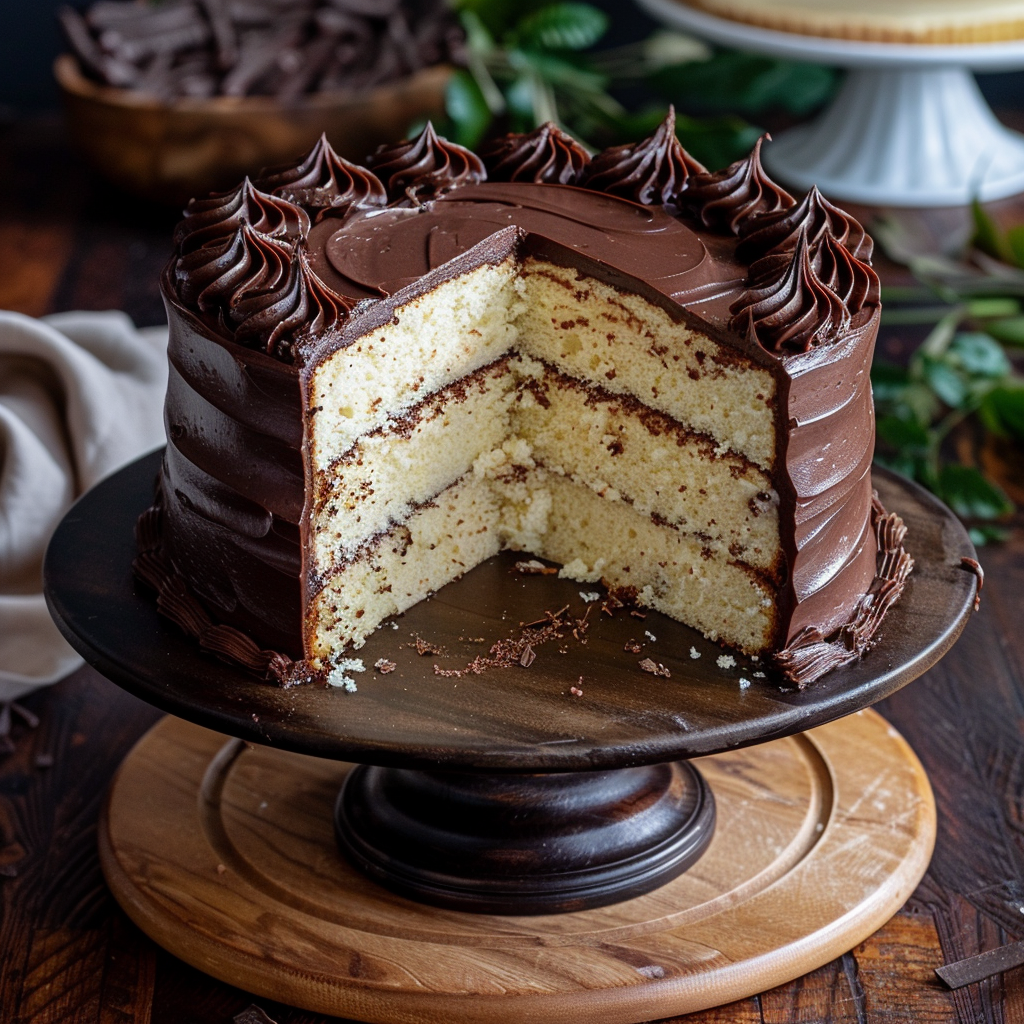Vanilla Cake with Chocolate Frosting: The Classic Duo
Vanilla cake with chocolate frosting is a beloved classic combination that has graced the tables of countless celebrations. The light and fragrant vanilla sponge perfectly complements the rich, creamy chocolate frosting, creating a flavor pairing that is universally adored. Whether served at birthday parties, weddings, or any special gathering, this delightful dessert embodies joy and togetherness. In this article, we will dive deep into the world of this iconic cake, exploring its origins, offering expert baking tips, and providing a detailed recipe to help you master the art of baking a vanilla cake with chocolate frosting.
The Origin of Vanilla Cake and Chocolate Frosting
Tracing the Roots of Vanilla Cake and Chocolate Frosting
Vanilla cake with chocolate frosting is a beloved classic that combines the delicate flavors of vanilla with the rich decadence of chocolate. This iconic pairing traces its roots to early American baking traditions. Vanilla cake first gained popularity in the 19th century as vanilla extract became more widely available, allowing bakers to incorporate the subtle sweetness of vanilla into their cakes.
Meanwhile, chocolate frosting evolved alongside the rise of chocolate consumption, particularly in the U.S. around the same time. While chocolate icing became more refined, its perfect match was discovered in the form of vanilla cake, providing a harmonious contrast of flavors. Today, this combination remains a staple of celebrations and family gatherings.
Ingredients Breakdown
Vanilla Cake Base
- Flour: Forms the foundation of the cake, giving it structure.
- Sugar: Provides sweetness and aids in browning.
- Butter: Adds moisture and richness.
- Eggs: Bind the ingredients and help the cake rise.
- Milk: Offers moisture and a tender crumb.
- Vanilla Extract: Delivers the signature vanilla flavor.
Chocolate Frosting Components
- Cocoa Powder: The essential component that brings the deep chocolate flavor.
- Butter: Provides creaminess and structure.
- Powdered Sugar: Sweetens and thickens the frosting.
- Milk or Cream: Helps achieve a spreadable consistency.
- Vanilla Extract: Adds depth to complement the chocolate.
Choosing the Right Vanilla and Chocolate
- Vanilla: Opt for high-quality vanilla extract or vanilla beans for the most authentic flavor. Imitation vanilla can work in a pinch but lacks the complexity of the real thing.
- Chocolate: Use unsweetened cocoa powder in frosting for the deepest flavor. If adding melted chocolate, choose a high-quality brand with a cocoa percentage that matches your desired sweetness level.
Putting it all together, the combination of these quality ingredients ensures that this dessert retains its reputation as a timeless favorite for every occasion.
Baking Tips of Vanilla Cake and Chocolate Frosting
Perfecting the Vanilla Cake Base

- Room Temperature Ingredients: Bring eggs, butter, and milk to room temperature before mixing. This ensures even blending and prevents lumps.
- Proper Creaming: Cream butter and sugar thoroughly until light and fluffy to trap air, giving your cake a tender crumb.
- Don’t Overmix: Once flour is added, mix until just combined to avoid a dense, tough cake.
Crafting the Creamiest Chocolate Frosting
- Sift Powdered Sugar and Cocoa: Sifting removes lumps for a smooth and creamy texture.
- Beat Butter First: Whip the butter until creamy before adding other ingredients to make sure the frosting is silky.
- Add Liquid Gradually: Incorporate milk or cream slowly to achieve the desired consistency. Too much too fast may make the frosting runny.
Combining Flavors for Balance
- Taste Test: Make sure the frosting isn’t overly sweet or bitter by tasting as you go.
- Adjust Texture: The frosting should be spreadable but firm. Increase the sugar for a thicker consistency or add more milk to make it thinner if necessary.
- Layering Balance: Ensure each layer of cake has an even amount of frosting to prevent overwhelming the cake’s flavor.
Vanilla Cake Recipe
Gathering the Ingredients
- 2 ½ cups all-purpose flour
- 2 ½ tsp baking powder
- ½ tsp salt
- 1 ½ cups granulated sugar
- ¾ cup unsalted butter, room temperature
- 4 large eggs, room temperature
- 1 cup whole milk, room temperature
- 2 tsp vanilla extract
Mixing and Preparing the Batter
- Preheat Oven: Set the oven to 350°F (175°C). Grease and flour two 8-inch cake pans.
- Sift Dry Ingredients: In a bowl, sift together flour, baking powder, and salt.
- Cream Butter and Sugar: In a separate bowl, beat butter and sugar until light and fluffy.
- Add Eggs: Add eggs one at a time, beating well after each addition. Stir in vanilla extract.
- Incorporate Dry Ingredients: Add flour mixture to the butter mixture in three batches, alternating with milk. Begin and end with flour.
- Divide Batter: Pour batter evenly into the prepared cake pans.
Baking and Cooling
- Bake: Bake in the preheated oven for 25-30 minutes or until a toothpick inserted into the center comes out clean.
- Cool: Allow cakes to cool in pans for 10 minutes before turning them out onto a wire rack to cool completely.
Common Mistakes and Fixes
- Overmixing: Leads to dense cake. Mix just until combined once flour is added.
- Baking Time: Too much baking causes dryness. Check 5 minutes before the recommended baking time.
- Uneven Rise: Ensure proper mixing and use fresh baking powder for consistent leavening.
- By following these steps, you can create a moist, tender vanilla cake that’s perfectly complemented by rich chocolate frosting.
Chocolate Frosting Recipe
Selecting High-Quality Chocolate
- Cocoa Powder: Choose unsweetened cocoa powder or Dutch-processed cocoa for different flavor profiles. The former has a stronger, slightly acidic taste, while the latter offers a milder flavor.
- Bittersweet Chocolate: For a richer taste, consider using melted bittersweet chocolate in the frosting. Look for chocolate with a high cocoa percentage for deeper flavor.
- Avoid Low-Quality Brands: Inferior chocolate can contain added fillers and fats that detract from flavor and texture.
Making the Frosting Step by Step
- Gather Ingredients: Ensure all ingredients are at room temperature, especially the butter and cream.
- Cream the Butter: Beat softened butter until fluffy and smooth.
- Add Cocoa and Sugar: Gradually add sifted cocoa powder and powdered sugar while mixing at low speed to prevent lumps and minimize airborne powder.
- Incorporate Liquid: Add cream/milk and vanilla extract gradually, adjusting the quantity to achieve desired consistency.
- Whip to Perfection: Whip the mixture at high speed for several minutes until the frosting is light and airy.
Common Errors to Avoid
- Grainy Texture: Can result from unmixed cocoa or sugar. Sift thoroughly and mix until smooth.
- Runny Consistency: Adding too much liquid or using overly soft butter can make frosting too thin. Gradually add powdered sugar to thicken if needed.
- Hard Butter: If butter is too firm, it won’t incorporate well. Allow it to sit out until it is soft but not melted.
Variations of Vanilla Cake and Chocolate Frosting

Adding Flavor Twists to the Vanilla Cake with Chocolate Frosting
- Citrus Zest: Incorporate lemon or orange zest into the batter to infuse a fresh, vibrant citrus flavor.
- Nutty Additions: Finely ground almonds, hazelnuts, or pistachios can add depth and a delightful crunch.
- Spices: A dash of cinnamon, nutmeg, or cardamom can introduce subtle warmth and complexity.
Creative Chocolate Frosting Variations
- Mint-Chocolate: Add peppermint extract for a refreshing twist.
- Espresso-Chocolate: Dissolve espresso powder in the cream for a mocha-inspired flavor.
- Salted Caramel: Swirl salted caramel sauce into the frosting or drizzle on top for a sweet-salty combo.
Combining Other Desserts
- Cupcake Delight: Use the same vanilla cake recipe for cupcakes, pairing with chocolate frosting for individual treats.
- Layer Cake Extravaganza: Alternate layers of vanilla and chocolate cake for a stunning presentation.
- Cake Pops: Crumble leftover cake and mix with frosting to create bite-sized cake pops, coating them in chocolate or sprinkles.
These variations offer creative ways to personalize the classic combination of vanilla cake and chocolate frosting, making your dessert truly unique.
Decorating Ideas of Vanilla Cake and Chocolate Frosting

Layering the Cake
- Even Layers: Trim the tops of your cake layers to ensure a flat surface. This prevents the cake from tilting and helps the frosting spread evenly.
- Fillings: Consider adding a layer of jam, fruit preserves, or whipped cream between cake layers for added flavor.
- Multiple Layers: For an impressive presentation, bake two to four layers, stacking them with frosting and fillings in between.
Frosting Techniques and Designs
- Rustic Swirls: Use a spatula or the back of a spoon to create rustic swirls and peaks on the frosting, giving the cake a homemade yet stylish look.
- Smooth Finish: For a professional appearance, apply a thin crumb coat and chill the cake before adding a final smooth layer of frosting with an offset spatula.
- Piping: Fill a piping bag with frosting and use different tips to pipe rosettes, shells, or other patterns for added elegance.
Incorporating Fresh Fruit and Nuts
- Berries: Decorate the cake with a medley of fresh berries for a burst of color and flavor.
- Citrus: Sliced oranges, lemons, or limes can add a refreshing visual contrast.
- Nuts: Add texture with toasted almond slivers, crushed hazelnuts, or pecan halves sprinkled over the frosting or used as a border.
Serving Suggestions of Vanilla Cake and Chocolate Frosting
Pairing with Beverages
- Coffee: The deep flavors of coffee complement the sweetness of the cake and frosting.
- Milk: A classic pairing that balances out the rich chocolate frosting with a simple, refreshing contrast.
- Dessert Wines: A sweet, fortified wine like port or sherry enhances the dessert’s flavors.
Making It the Star of a Dessert Table
- Theme Coordination: Match your cake decorations to the event theme, using specific colors, shapes, or other dessert items.
- Multiple Cake Stands: Arrange smaller cakes or cupcakes on varying heights of cake stands for a stunning visual display.
- Complimentary Treats: Surround the main cake with complementary sweets, like macarons, cookies, or truffles, for variety.
With these decorating ideas and serving suggestions, your vanilla cake with chocolate frosting will shine as the star of any event or celebration.
Storing and Freezing
Keeping Your Cake Fresh
- Short-Term Storage: If you plan to eat the cake within 2-3 days, store it in an airtight container or cover it with plastic wrap to retain moisture.
- Room Temperature: Keep the cake at room temperature if the frosting does not contain perishable ingredients (like whipped cream or custard). Place it in a cool, dry spot away from direct sunlight or heat.
- Refrigeration: If the cake contains dairy-based fillings or frosting, refrigerate it. Cover it with plastic wrap or place it in an airtight container to prevent it from drying out or absorbing other food odors.
Freezing Tips for Later Enjoyment
- Pre-Freeze Layers: Before fully assembling and frosting the cake, freeze individual layers wrapped tightly in plastic wrap and then aluminum foil. This method prevents freezer burn.
- Frosting the Cake: If you need to freeze a fully frosted cake, place it uncovered in the freezer for an hour to harden the outer layer. Once set, wrap the entire cake in plastic wrap and then in a layer of aluminum foil.
- Thawing: To thaw, transfer the cake to the refrigerator overnight, keeping it covered until it reaches room temperature. For a frosted cake, remove the plastic wrap but keep it covered loosely to prevent condensation from forming on the frosting.
- Label and Date: Always label and date the frozen cake to ensure freshness. Consume within 3 months for optimal flavor and texture.
With these tips, your vanilla cake with chocolate frosting will remain delicious and moist whether enjoyed immediately or after a period in the freezer.
Vanilla Cake with Chocolate Frosting FAQs
What cake flavors go with chocolate frosting?
Chocolate frosting pairs beautifully with a variety of cake flavors beyond vanilla. Here are some complementary options:
- Yellow Cake: Similar to vanilla but richer due to extra egg yolks.
- Red Velvet: The mild cocoa flavor pairs well with the chocolate frosting’s deeper notes.
- Banana Cake: The sweetness of banana contrasts nicely with chocolate.
- Carrot Cake: A spiced carrot cake gains an extra layer of indulgence with chocolate frosting.
Can I add cocoa to the vanilla frosting?
Yes, you can transform vanilla frosting into chocolate frosting by adding cocoa powder. Gradually mix in unsweetened cocoa powder to your taste, starting with a few tablespoons. You may also need to add more liquid (milk or cream) to achieve the desired consistency. Make sure to sift the cocoa powder first to avoid lumps.
What is chocolate frosting called?
Chocolate frosting is commonly referred to simply as “chocolate frosting,” though it can also go by specific names depending on the ingredients and preparation:
- Chocolate Buttercream: Made with cocoa or melted chocolate and whipped with butter.
- Chocolate Ganache: A rich blend of melted chocolate and heavy cream, used as a glaze or whipped for frosting.
Chocolate Fudge Frosting: Dense and often made with cocoa powder or melted chocolate, sugar, and butter.
What are the 5 types of cakes?
While there are many types of cakes, here are five popular ones:
- Butter Cake: Includes classics like pound cake and yellow cake, using butter as the main fat.
- Sponge Cake: Light and airy, made without butter and usually relying on whipped eggs for volume.
- Chiffon Cake: Combines the richness of butter cakes and the fluffiness of sponge cakes using oil and whipped egg whites.
- Genoise: An Italian or French sponge cake often used as the base for layered or rolled cakes.
- Flourless Cake: Includes gluten-free options, like flourless chocolate cake, often relying on eggs and other ingredients for structure.
These diverse cakes offer different textures, flavors, and possibilities for pairing with various frostings, including chocolate!

1 thought on “Classic Vanilla Cake with Chocolate Frosting”